DOCSITY
Welcome to Docsity!!
Your digital haven for instant access to top-tier study materials!
Dive into a world of curated documents covering diverse subjects, crafted to elevate your learning journey.
With seamless access, unbeatable quality, and a customer-centric approach, Docsity is your shortcut to academic excellence.
Join us and redefine the way you learn.
Embrace Docsity — where knowledge meets convenience.
Happy studying!
- 258
- 0
- 17
Community
- Followers
- Following
275 items

SHADOWHEALTH MENTAL HEALTH TINA JONES Correctly Answered Questions, Questions and Answers with Explanations
SHADOWHEALTH MENTAL HEALTH TINA JONES/Correctly Answered Questions, Questions and Answers with Explanations SHADOW HEALTH | TINA JONES | CARDIOVASCULAR Questions with Correct SHADOW HEALTH TINA JONES RESPIRATORY ASSESSMENT Questions & SHADOW HEALTH TINA JONES HAIR, SKIN AND NAILS Shadow Health HEENT Tina Jones
- Package deal
- • 8 items •
- SHADOW HEALTH - HEENT TINA JONES | Questions with 100% Correct Answers | Verified | Updated • Exam (elaborations)
- SHADOW HEALTH | TINA JONES | RESPIRATORY Latest Updated A+ Guide Solution • Exam (elaborations)
- SHADOW HEALTH TINA JONES HEALTH HISTORY(Questions & Answers: Guaranteed A+ Guide • Exam (elaborations)
- Shadow Health HEENT Tina Jones/Questions with Correct Answers • Exam (elaborations)
- SHADOW HEALTH TINA JONES HAIR, SKIN AND NAILS/Questions & Answers: Guaranteed A+ Guide • Exam (elaborations)
- And more ….
SHADOWHEALTH MENTAL HEALTH TINA JONES/Correctly Answered Questions, Questions and Answers with Explanations SHADOW HEALTH | TINA JONES | CARDIOVASCULAR Questions with Correct SHADOW HEALTH TINA JONES RESPIRATORY ASSESSMENT Questions & SHADOW HEALTH TINA JONES HAIR, SKIN AND NAILS Shadow Health HEENT Tina Jones
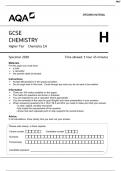
GCSE CHEMISTRY Higher Tier Chemistry 1H Specimen 2018 exam Questions
0 1 This question is about halogens and their compounds. Table 1 shows the boiling points and properties of some of the elements in Group 7 of the periodic table. Table 1 Element Boiling point in ° C Colour in aqueous solution Fluorine -188 colourless Chlorine -35 pale green Bromine X orange Iodine 184 brown 0 1 . 1 Why does iodine have a higher boiling point than chlorine? [1 mark] Tick one box. Iodine is ionic and chlorine is covalent Iodine is less reactive than chlorine ...
- Exam (elaborations)
- • 34 pages •
0 1 This question is about halogens and their compounds. Table 1 shows the boiling points and properties of some of the elements in Group 7 of the periodic table. Table 1 Element Boiling point in ° C Colour in aqueous solution Fluorine -188 colourless Chlorine -35 pale green Bromine X orange Iodine 184 brown 0 1 . 1 Why does iodine have a higher boiling point than chlorine? [1 mark] Tick one box. Iodine is ionic and chlorine is covalent Iodine is less reactive than chlorine ...
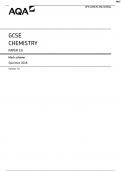
GCSE CHEMISTRY PAPER 1H Mark scheme Specimen
Question Answers Extra information Mark AO / Spec. Ref 01.1 The forces between iodine molecules are stronger 1 AO1/1 4.2.2.4 AO1 01.2 anything in range +30 to +120 1 AO3/2a 4.1.2.6 01.3 Brown 1 AO2/1 4.1.2.6 01.4 2 I− + Cl2 → I2 + 2 Cl− 1 AO2 /1 4.1.2.6 4.1.1.1 01.5 It contains ions which can move 1 AO1/1 4.2.2.3 01.6 hydrogen iodine 1 AO2/1 4.4.3.4 Total 6. Question 2 Question Answers Extra information Mark AO / Spec. Ref. 02.1 13 (protons) 14 (neutrons) 13 (e...
- Exam (elaborations)
- • 21 pages •
Question Answers Extra information Mark AO / Spec. Ref 01.1 The forces between iodine molecules are stronger 1 AO1/1 4.2.2.4 AO1 01.2 anything in range +30 to +120 1 AO3/2a 4.1.2.6 01.3 Brown 1 AO2/1 4.1.2.6 01.4 2 I− + Cl2 → I2 + 2 Cl− 1 AO2 /1 4.1.2.6 4.1.1.1 01.5 It contains ions which can move 1 AO1/1 4.2.2.3 01.6 hydrogen iodine 1 AO2/1 4.4.3.4 Total 6. Question 2 Question Answers Extra information Mark AO / Spec. Ref. 02.1 13 (protons) 14 (neutrons) 13 (e...
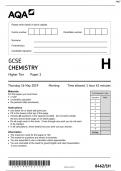
GCSE CHEMISTRY Higher Tier Paper 1 JUNE 2019Tested Questions
0 1 This question is about the periodic table. In the 19th century, some scientists tried to classify the elements by arranging them in order of their atomic weights. Figure 1 shows the periodic table Mendeleev produced in 1869. His periodic table was more widely accepted than previous versions . 1 The atomic weight of tellurium (Te) is 128 and that of iodine (I) is 127 Why did Mendeleev reverse the order of these two elements?
- Exam (elaborations)
- • 32 pages •
0 1 This question is about the periodic table. In the 19th century, some scientists tried to classify the elements by arranging them in order of their atomic weights. Figure 1 shows the periodic table Mendeleev produced in 1869. His periodic table was more widely accepted than previous versions . 1 The atomic weight of tellurium (Te) is 128 and that of iodine (I) is 127 Why did Mendeleev reverse the order of these two elements?
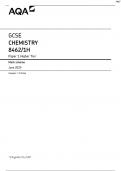
GCSE CHEMISTRY 8462/1H Paper 1 Higher Tier MS June 2019 100%CORRECT
Question Answers Extra information Mark AO / Spec. Ref 01.1 any one from: • so elements / iodine / tellurium were in groups with similar properties • iodine has similar properties to Br / Cl / F / Group 7 • iodine has different properties to Se / S / O / Group 6 ignore reference to atomic structure ignore references to Cr, Mn and Mo allow corresponding argument in terms of tellurium 1 AO1 4.1.2.2 01.2 Mendeleev had predicted properties of missing elements ...
- Exam (elaborations)
- • 26 pages •
Question Answers Extra information Mark AO / Spec. Ref 01.1 any one from: • so elements / iodine / tellurium were in groups with similar properties • iodine has similar properties to Br / Cl / F / Group 7 • iodine has different properties to Se / S / O / Group 6 ignore reference to atomic structure ignore references to Cr, Mn and Mo allow corresponding argument in terms of tellurium 1 AO1 4.1.2.2 01.2 Mendeleev had predicted properties of missing elements ...
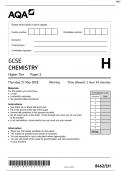
GCSE CHEMISTRY Higher Tier Paper 1 EXAM QUESTIONS
1 Soluble salts are formed by reacting metal oxides with acids. box 0 1 . 1 Give one other type of substance that can react with an acid to form a soluble salt. [1 mark] 0 1 . 2 Calcium nitrate contains the ions Ca2+ and NO3 – Give the formula of calcium nitrate. [1 mark] 0 1 . 3 Describe a method to make pure, dry crystals of magnesium sulfate from a metal oxide and a dilute acid. 0 2 This question is about metals and metal compounds. box 0 2 . 1 Iron pyrites is an ionic compound....
- Exam (elaborations)
- • 28 pages •
1 Soluble salts are formed by reacting metal oxides with acids. box 0 1 . 1 Give one other type of substance that can react with an acid to form a soluble salt. [1 mark] 0 1 . 2 Calcium nitrate contains the ions Ca2+ and NO3 – Give the formula of calcium nitrate. [1 mark] 0 1 . 3 Describe a method to make pure, dry crystals of magnesium sulfate from a metal oxide and a dilute acid. 0 2 This question is about metals and metal compounds. box 0 2 . 1 Iron pyrites is an ionic compound....

GCSE Chemistry 8462/1H – PAPER 1 – HIGHER TIER Mark scheme 100% verified
GCSE Chemistry 8462/1H – PAPER 1 – HIGHER TIER Mark scheme 01.1 any one from: • metal • (metal) hydroxide • (metal) carbonate • alkali allow named example allow correct formula ignore base allow ammonium hydroxide allow ammonium carbonate allow soluble base allow ammonia 1 AO1 4.4.2.1 4.4.2.2 4.4.2.3 01.2 Ca(NO3)2 allow Ca2+(NO3 - ) 2 1 AO2 4.4.2.2
- Exam (elaborations)
- • 29 pages •
GCSE Chemistry 8462/1H – PAPER 1 – HIGHER TIER Mark scheme 01.1 any one from: • metal • (metal) hydroxide • (metal) carbonate • alkali allow named example allow correct formula ignore base allow ammonium hydroxide allow ammonium carbonate allow soluble base allow ammonia 1 AO1 4.4.2.1 4.4.2.2 4.4.2.3 01.2 Ca(NO3)2 allow Ca2+(NO3 - ) 2 1 AO2 4.4.2.2
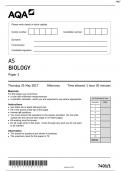
June 2017 QP (v1) Paper 1 AQA Biology AS-level.
0 1 Figure 1 shows part of a DNA molecule 0 1 . 1 How many nucleotides are shown in Figure 1? [1 mark] 0 1 . 2 Name the type of bond labelled X in Figure 1 0 1 . 3 The enzymes DNA helicase and DNA polymerase are involved in DNA replication. Describe the function of each of these enzymes. [2 marks] DNA helicase DNA polymerase 0 1 . 4 Adenosine triphosphate (ATP) is a nucleotide derivative. Contrast the structures of ATP and a nucleotide found in DNA to give two differences.
- Exam (elaborations)
- • 28 pages •
0 1 Figure 1 shows part of a DNA molecule 0 1 . 1 How many nucleotides are shown in Figure 1? [1 mark] 0 1 . 2 Name the type of bond labelled X in Figure 1 0 1 . 3 The enzymes DNA helicase and DNA polymerase are involved in DNA replication. Describe the function of each of these enzymes. [2 marks] DNA helicase DNA polymerase 0 1 . 4 Adenosine triphosphate (ATP) is a nucleotide derivative. Contrast the structures of ATP and a nucleotide found in DNA to give two differences.
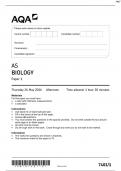
Paper 1 AQA Biology AS-level ACTUAL QUESTIONS
Table 1 shows features of a bacterium and the human immunodeficiency virus (HIV) particle. Complete Table 1 by putting a tick () where a feature is present. [2 marks] Table 1 Feature Bacterium Human immunodeficiency virus (HIV) particle RNA Cell wall Enzyme molecules Capsid 0 1 . 2 When HIV infects a human cell, the following events occur. • A single-stranded length of HIV DNA is made. • The human cell then makes a complementary strand to the HIV DNA. The complementa...
- Exam (elaborations)
- • 24 pages •
Table 1 shows features of a bacterium and the human immunodeficiency virus (HIV) particle. Complete Table 1 by putting a tick () where a feature is present. [2 marks] Table 1 Feature Bacterium Human immunodeficiency virus (HIV) particle RNA Cell wall Enzyme molecules Capsid 0 1 . 2 When HIV infects a human cell, the following events occur. • A single-stranded length of HIV DNA is made. • The human cell then makes a complementary strand to the HIV DNA. The complementa...
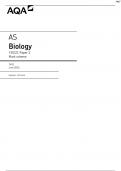
Biology 7401/1 Paper 1 Mark scheme Complete with Answers Verified and Graded 2024 Update
Mark scheme instructions to examiners 1. General The mark scheme for each question shows: • the marks available for each part of the question • the total marks available for the question • the typical answer or answers which are expected • extra information to help the examiner make his or her judgement and help to delineate what is acceptable or not worthy of credit or, in discursive answers, to give an overview of the area in which a mark or marks may be awarded. The ...
- Exam (elaborations)
- • 15 pages •
Mark scheme instructions to examiners 1. General The mark scheme for each question shows: • the marks available for each part of the question • the total marks available for the question • the typical answer or answers which are expected • extra information to help the examiner make his or her judgement and help to delineate what is acceptable or not worthy of credit or, in discursive answers, to give an overview of the area in which a mark or marks may be awarded. The ...
